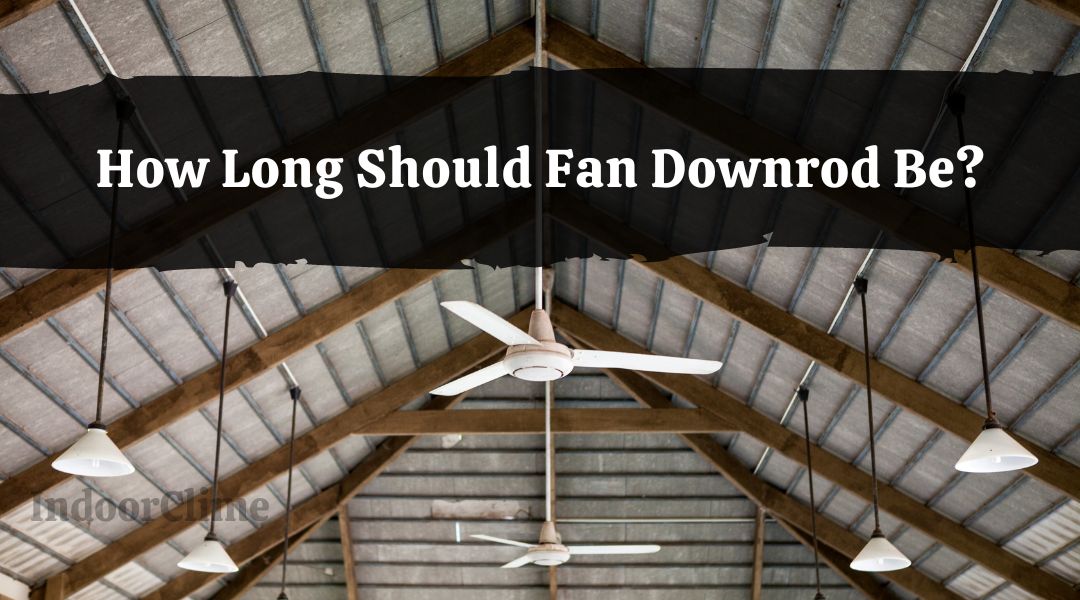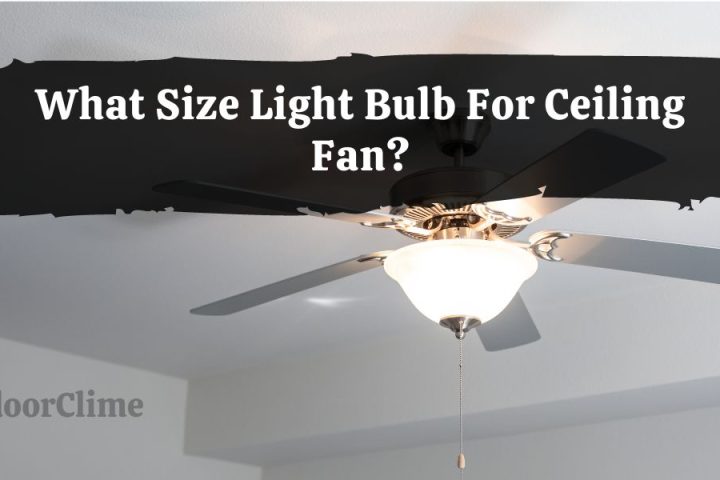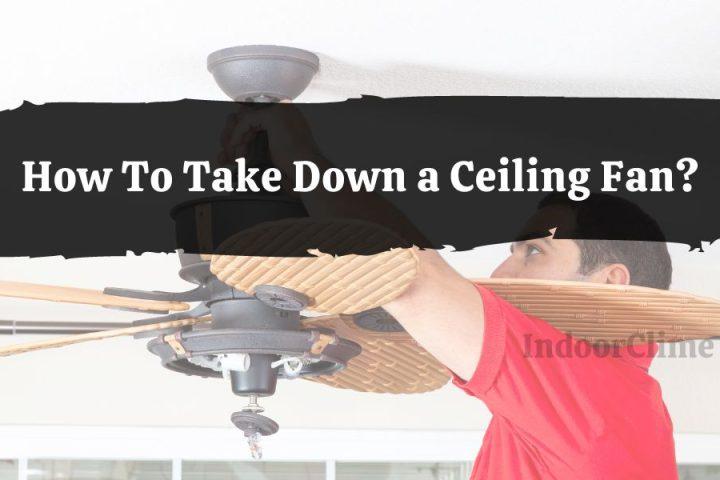The most typical way of determining the proper downrod length is to take the ceiling height, remove the height of the ceiling fan (most fans range in height from 12 to 18 inches depending on the fan), and then deduct the required hanging height (usually eight feet).
What Is a Downrod?

A downrod is an extension pipe that links your fan’s motor housing to the ceiling mounting hardware. If your ceiling height permits the usage of a downrod, it is advised to aid in improving the operation of your fan.
It also increases the gap between the ceiling and the fan motor. As a result, the engine and the blade may continue to function continuously. Depending on the type of fan, it can also come in various lengths and widths.
Regardless of the model, it varies in size, shape, and functions or generates varied outcomes.
However, the download’s secondary function is to ensure a secure installation. It also allows the fan to function properly.
Does Downrod Length Affect Airflow?
A downrod also assists in appropriate airflow by establishing a safe gap of at least eight to ten inches between the ceiling fan blades and a minimum distance of seven feet between the fan blades and the floor.
Every ceiling fan creates airflow by being hung in the air (measured in CFMs). However, certain positions are superior to others. We shall look at ceiling fan extension rods (downrods) sizes.
How Long Should Fan Downrod Be?

Ensure the downrod length is appropriate to get the most out of a ceiling fan. If properly configured, you will get the full heating or cooling benefits.
To get the right length for a ceiling fan extension rod, hang a fan between 7 and 9 feet or about 8 feet above the ground.
Given a fixed ceiling height, the downrod lengths are as follows:
| Ceiling Height: | Downrod Length: |
| 8 ft | 10 or 12 inches |
| 9 ft | 12 inches |
| 10 ft | 24 inches |
| 11 ft | 36 inches |
| 12 ft | 48 inches |
| 13 ft | 60 inches |
| 14 ft | 72 inches |
| 15 ft | 84 inches |
| 16 ft | 96 inches |
Here’s how to calculate a downrod length:
Ceiling height = 8 ft + downrod length
That is, you can determine the downrod length required for a ceiling fan using the following formula:
Downrod length = ceiling height – 8 ft
Assume you have a 10-foot-6-inch ceiling height. This downrod equation yields:
Downrod length = 10 ft 6 in – 8 ft = 2 ft 6 in = 30 in
Can You Put a Downrod On Any Fan? (Are All Downrods the Same?)
Some models require specialized downrods. However, most downrods are interchangeable if the same company manufactures them.
Once you’ve chosen the length and fan manufacturer, select the internal diameter, threaded vs. non-threaded, color, and finish.
How Do I Choose a Downrod?

Some people construct a download-based plan and “jimmy” to match their needs. This approach is neither safe nor advised, and it may have several negative repercussions on the operation and security of your ceiling fan.
While the fan is running, an inexpensively made or improperly connected downrod may cause instability. This could cause the ceiling fan to wobble, stressing the fan and all the fittings and fixtures, keeping it in place.
The instability resulted in more wear and tear and an increased risk of component failure. When a malfunction occurs, this can endanger everyone in the room. As the fan blades turn around, the fan’s instability could potentially force it to fall lower than is safe, endangering anyone in the room.
Because making a downrod is time-consuming, you need a sturdy material. As a result, it employs a durable and resistant substance to ensure longevity and excellent performance.
As a result, when purchasing a ceiling fan, verify the length of the downrod before completing your purchase. The size will impact the airflow between the ceiling fan and the blade.
Finally, make sure the downrod is completely tight. To identify the overall optimization and suitable adjustment of the many external circumstances associated with a ceiling fan.
A downrod ceiling fan’s working mechanism is as follows:
1. Using the Downrod Selection Principle
The downrod raises it slightly above the ground. Consequently, the blades do not have to work as hard before the airflow distributes the whole area. When installing a new ceiling fan, keep a gap of 7 feet between the floor and the fan.
2. Examine Your Ceiling Height
Your normal ceiling height is 2400mm. However, if the height exceeds the requirement of 2400mm, the downrod is recommended for efficient ventilation. Most ceiling fans, however, have ideal airflow routes at a greater height.
3. Determine the overall height of the ceiling fan
When purchasing a ceiling fan, be aware of its height. The height is measured from the top fan canopy to the bottom of the fan blades.
4. Examine Any Ceiling Angle
Downrods are best suited for pitched or sloped ceilings. When the downrod is too short, you must hang your ceiling fan too near.
It will also hit the sloping ceiling, depending on the pitch of the ceiling. As a result, use a downrod to lower the ceiling fan positioning to solve this issue.
Furthermore, check that the canopy of your ceiling fan has a mechanism to allow the rod to move. Allow it to hang vertically from the inclined ceiling.
5. Calculate the available height
After determining your ceiling and fan height, determine where you want to hang it.
6. Installment
Select a location for installing a ceiling fan with a downrod mount that enables even air circulation throughout the space. Remember the suggested distance once you’ve chosen a spot for your ceiling fan.
Also, study the product handbook guide attentively for a thorough understanding, and be aware of the appropriate distance and length of a downrod. It is also a reversible procedure if your fan is installed. So, strive to reduce the space between your downrod and the suitable height.
7. Fanning
When the fan spins around, the downrod will keep it from dropping due to the tightness of the knot. It will also be flexible enough to rotate the ceiling fan blade.
Furthermore, the fan must be extended below the ceiling to supply airflow efficiently. The blades move uniformly to provide a powerful force that keeps the space cold and silent.
How Do I Choose a Size And Sort Of Downrod?
It’s helpful to know that there are four sorts of downrods to be aware of (in order of length):
Standard mount
Small downrods range from 3 to 5 inches long (metal pipes). In most circumstances, an extra downrod will be required to lower the ceiling fan to around 8 feet over the ground.
Extended mount
In rooms with higher-than-average ceiling heights, these are used to hang ceiling fans. They can be anything from 6 and 120 inches long.
Use the downrod length table or calculator to calculate the length of an extension rod.
Flush mount
These are intended for ceilings that are less than 8 feet high. They are also known as “hugger fans” or “low-profile supporters.”
A word of caution concerning these low-profile fans: they do not move as much air as regular ceiling fans are less efficient, and frequently do not adhere to the third criterion above.
Sloped mount
A slanted downrod is used when the ceiling is inclined (at an angle). This downrod is specifically intended for use with sloping ceilings.
Even more crucial than selecting the appropriate length downrod is selecting the appropriate ceiling fan size.
A. UL Rating
The first consideration is the downrod’s UL rating. The fan and it will both have the same UL rating. If your fan is wet-rated, your downrod should likewise be wet-rated. This must be done correctly because a flawed rod will rust very quickly.
B. Diameter
The diameter of the downrod is the second factor. The diameter of the current down rod should be measured. To ensure the new downrod will fit on the fan and ceiling connections, you must find one with the same diameter as the old one.
C. Connection
The downrod’s connection method is the third factor that must be considered at all costs. You must purchase a threaded downrod if your present downrod is threaded. You must choose a new downrod with pinholes in the same place if your old downrod connects with pins.
Bringing your old downrod as a sample when you visit your neighborhood home décor shop to find a replacement downrod is the best way to ensure you obtain the right one. Doing so may verify that your requirements have been satisfied before leaving the business.
FAQ
Do I Need a Downrod For a 9-Foot Ceiling?
Yes, on a 9-foot ceiling, we also advise using the conventional downrod. A 6-inch downrod will, however, be included by some manufacturers.
We advise using a 6-inch downrod if your fan has one, on a 9-foot ceiling.
Can a ceiling fan Downrods be cut?
Yes, although downrods cannot be bought in a specific length, they can be custom cut if not threaded at both ends. A downrod for a ceiling fan can be shorter by cutting it at one end and drilling a hole to fit the hanging pin.
Even though downrod sets can be bought, your electrician can usually trim them to size, so always err on caution and extend if in doubt.
Can you connect 2 Downrods?
Yes. A coupler is a point at which two downrods can be coupled to extend a downrod past the length advertised for individual downrods. Both the downrods and each coupler have manufacturer-specific features.
Two downrods can be joined together to form larger lengths using fan downrod couplers.
Can I reuse a ceiling fan Downrod?
No. Downrods for ceiling fans are neither universal nor interchangeable, and they shouldn’t be used as such. Each one could have a distinct size, color, and safety rating. They could also use different installation techniques.
Even within one model, downrods for ceiling fans are not always interchangeable. A provider might create various ceiling fan models for various uses, each with a unique downrod design. Therefore, while there may be some degree of downrod interchangeability, there is no assurance.
You could discover that some downrods of different ceiling fan models from the same manufacturer are interchangeable. However, you shouldn’t buy a downrod assuming the components will be compatible since the manufacturer is the same.
If you want to replace your ceiling fan downrod, you need to gather some information about your ceiling fan to ensure that the new downrod you buy will work with it.





